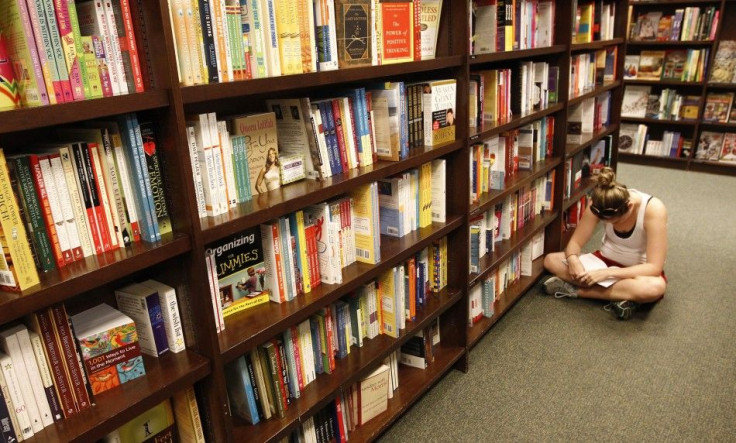Barnes & Noble's Big Box Challenge: Enough Sales for Relevance

Borders is closing, lending some to question what the impact will be on Barnes & Noble, America's largest national bookstore chain.
Among the leading reasons cited in Borders' failure is that the company's large brick and mortar stores didn't sell enough items to pay for costly rents, considering Borders stores averaged 25,000 square feet in many prime locations.
Even though Barnes & Noble doesn't appear anywhere close to liquidation status, the company still faces stiff headwinds blowing in a changing book retail environment that leans toward digital product, not hardcover books sold in brick and mortar stores.
So the question becomes in light of Borders' closing: Can Barnes & Noble succeed with hundreds of superstore bookstores spread across America?
IBTimes decided to check out the Barnes & Noble closest to our office in New York to find out just how much customer traffic and purchases are made in one of the nation's biggest markets at a store on a given day.
During a one hour time period selected, between 10 a.m. and 11 a.m., IBTimes observed a Barnes & Noble store in the Tribeca area. In that time frame, 24 customers purchased a product according to the unofficial count.
That's compared to approximately 150 people that walked in and out of the store during that time period.
Among the most interesting observations was the amount of women that came in with young children. During the one hour time period, 48 women, some mothers and some nannies, came into the 36,000 square feet store. The majority wheeled in strollers with children under the age of five along for the ride.
Most striking was that only six of the 48 women that came in actually bought anything.
The majority apparently brought children in for Storybook Time, which according to one Barnes & Noble employee, is meant to encourage reading, and is not targeted at generating sales.
Too Big a Space, Too Many Products, Too Little Buying Customers
Scattered throughout the store was a large children's book section, and a large movie and CD section. The movie and television section was well-stocked, with many options, including a fairly large Western movie section. But even with all the options, pricing was an issue for one customer.
A middle-aged man came and asked about the pricing of The Wire DVD series. After learning the price, he remarked that he could actually buy it even cheaper on Barnes & Noble's Web site through a third-party vendor.
Customers seemed to enjoy their experience in the store, even if they weren't buying products. With comfy chairs and plenty of open tables throughout the store, Barnes & Noble makes it very comfortable for consumers to relax and hang out, and people weren't shy about doing just that.
The question is whether customers were comfortable buying products, books especially.
At one point 23 customers were sitting in the store's café. Some were drinking a beverage while reading a book, while others seemed content to surf the Internet on the store's free Wi-Fi Internet connection.
At around 11 a.m. on the day we visited the Barnes & Noble store in New York, most every chair in the store was occupied, with some people even sitting on the floor. Each person had a book or magazine in hand and didn't appear to be going anywhere anytime soon.
Among the most telling examples of the hangout issue was observed with a middle-aged man. The gray-haired man, sporting a grayish goatee, lingered around the magazine section of the store for close to 40 minutes. He read through about four to five magazines before eventually leaving the store completely empty-handed. He didn't buy anything.
Big Store Means High Costs
For Barnes & Noble, that's a problem since a large sized store New York's Tribeca neighborhood means much higher rent. It's not at the level of New York's Gold Coast, with monthly retail space rents typical anywhere from $600 to $1000 a square foot, but it's still costly. Assuming for analytic purposes that Barnes & Noble paid $100 a square foot for its Tribeca space, which according to market factors would be quite low, a 36,000-foot store commands a hefty monthly rent.
Under the $100 a square foot hypothetical, the bookstore would pay $3,600,000 a month in rent, not including utilities or other factors. In order to just break even on its rent, Barnes & Noble would need to bring in $4,918.13 in revenue an hour.
But of the 24 buyers observed in the hour IBTimes watched, the majority seemed to be buying only a book or magazine. For argument's sake, let's say that the average sale was $20, even though it was very likely lower. Using that number, Barnes & Noble would have made $480 during that hour, nowhere near the close to $5,000 amount needed to stay above the red.
Employees indicated that the store gets busier during lunch time and after-work hours, but to the tune of $4,000 more?
Another female employee, who worked in the movie section, indicated that part of the reason could be that there isn't a Subway stop in close proximity to the store. That might justify why the store was slow, but raises further questions as to why the store was still open in the first place.
It also raises questions about the future of Barnes & Noble's 704 other traditional retail bookstores throughout the country. If sales barely cover rent, America's largest bookstore chain likely has a challenging future ahead.
© Copyright IBTimes 2024. All rights reserved.





















